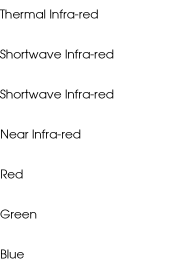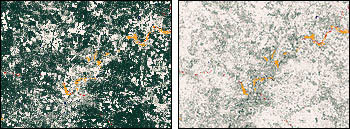

| Color Coordinating Satellites |
| |
 As can be seen through a prism, sunlight contains many different colors (wavelengths). When sunlight strikes
objects, certain wavelengths are absorbed and others are reflected or emitted.
The Landsat 5 and Landsat 7 satellites are sensitive to these different
types of light, including infrared wavelengths that cannot be seen with
the naked eye. Each satellite has several separate light detectors (photoreceptors)
on board, which measure the energy reflected or emitted by the Earth. One
light detector records only the blue light coming off the Earth (band 1).
Another observes all the yellow-green light (band 2), and still another
picks up on all the near-infrared light (band 4). The Landsat satellites
move in circular orbits very nearly from pole-to-pole around the Earth and
scan strip after strip of our revolving planet. Their data are beamed back
to the surface, where they can be processed into pictures.
As can be seen through a prism, sunlight contains many different colors (wavelengths). When sunlight strikes
objects, certain wavelengths are absorbed and others are reflected or emitted.
The Landsat 5 and Landsat 7 satellites are sensitive to these different
types of light, including infrared wavelengths that cannot be seen with
the naked eye. Each satellite has several separate light detectors (photoreceptors)
on board, which measure the energy reflected or emitted by the Earth. One
light detector records only the blue light coming off the Earth (band 1).
Another observes all the yellow-green light (band 2), and still another
picks up on all the near-infrared light (band 4). The Landsat satellites
move in circular orbits very nearly from pole-to-pole around the Earth and
scan strip after strip of our revolving planet. Their data are beamed back
to the surface, where they can be processed into pictures.
To differentiate between types of vegetation and their attributes, scientists take an image of an area using the Landsat satellites’ light detectors. The researchers then compare the different colors of light reflecting off a patch of land. They mix and match these colors until they come up with the combinations that most distinguish the types of vegetation and vegetation characteristics such as the density of foliage. The combination is processed and made into an image that can be easily analyzed (Townshend et, al., 1993).
|
 The Thematic Mapper instrument aboard several
of the Landsat satellites detects light in seven distinct bands. Red, green, and blue
bands can be combined to create pictures as we would see them Different band
combinations and comparisons reveal unique aspects of the Earth. (Image by Jesse Allen,
GSFC Viualization Analysis Lab)
The Thematic Mapper instrument aboard several
of the Landsat satellites detects light in seven distinct bands. Red, green, and blue
bands can be combined to create pictures as we would see them Different band
combinations and comparisons reveal unique aspects of the Earth. (Image by Jesse Allen,
GSFC Viualization Analysis Lab) | |
 An example can be found in the way satellites are used to separate areas of conifer trees from hardwood trees. Researchers know that evergreen conifer trees absorb more infrared light (light to the right of red on the color spectrum) and reflect more red light than hardwood trees (Parkinson, 1997). This information provides them with a system to tell the two tree types apart. If the difference of red to infrared light recorded by the satellite (bands 3 and 4) is high, then they know a patch of trees viewed by the satellite is hardwood. If the difference is low, then the trees are probably conifer (Parkinson, 1997). The scientists can create a map by highlighting the variation between the two wavelengths.
|
Vegetation maps derived from satellite data can do more than show the presence of vegetation - they can also distinguish between conifers (left) and broadleaf trees (right). Since spotted owls prefer nesting in douglas fir and other conifers, it is necessary to determine vegetation type to map suitable habitat. (Image by Janine Savage, Global Change Master Directory, based on data from the Interagency Vegetation Mapping Project) |